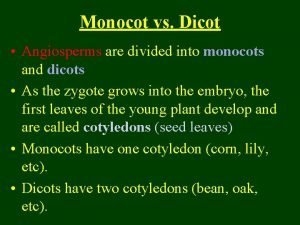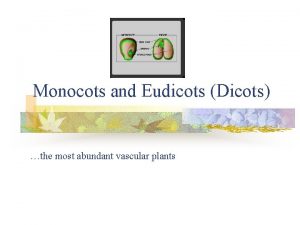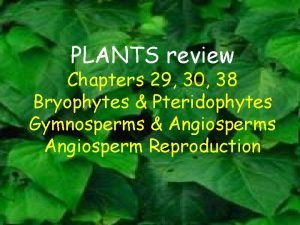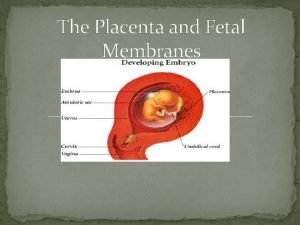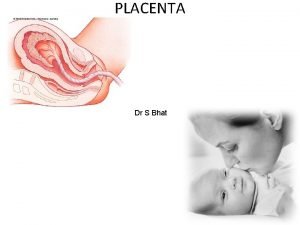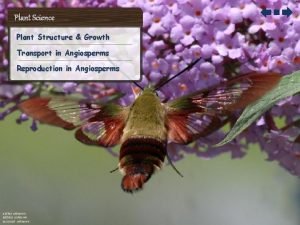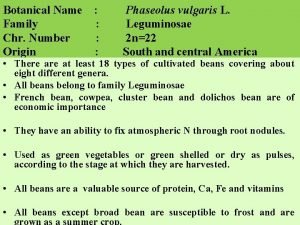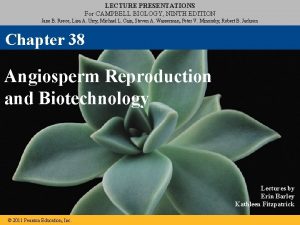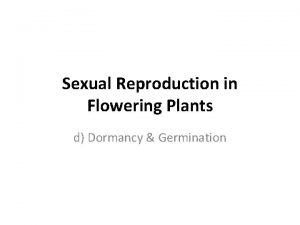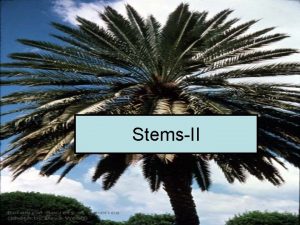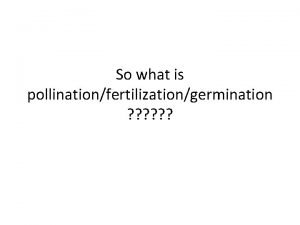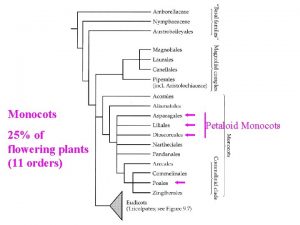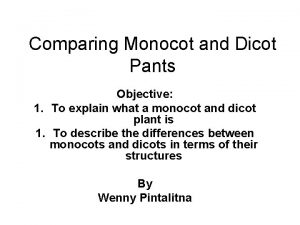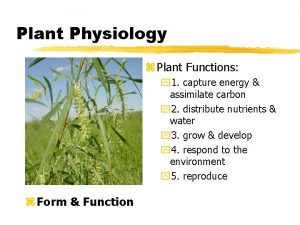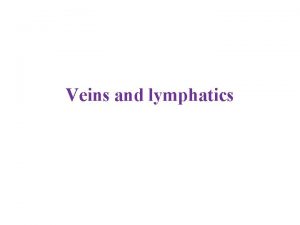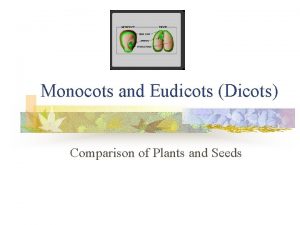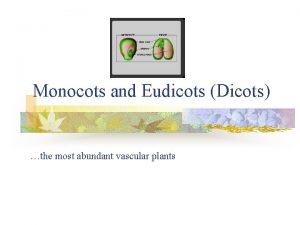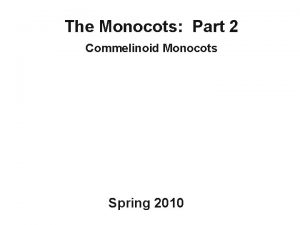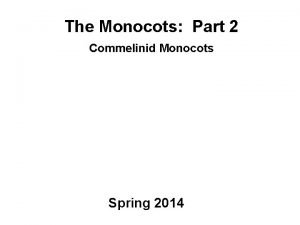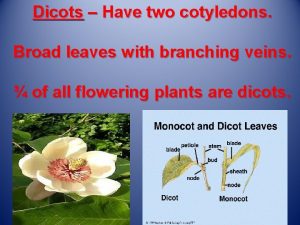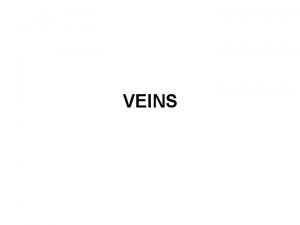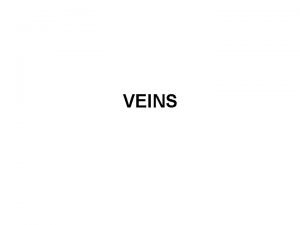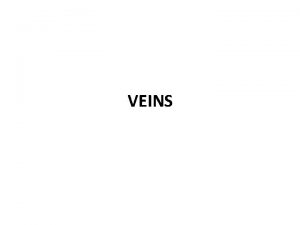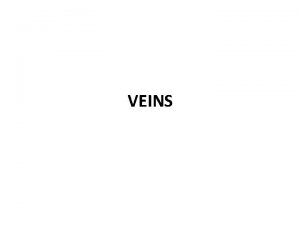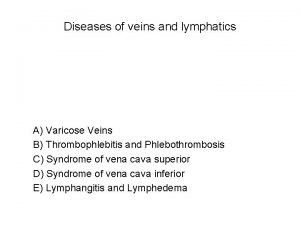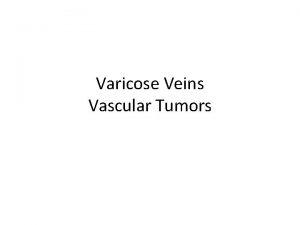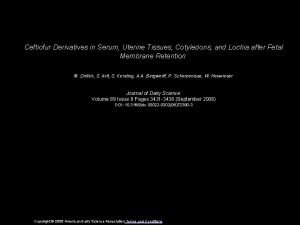Monocots Eudicots One cotyledon Two cotyledons Veins usually
























- Slides: 24

Monocots Eudicots One cotyledon Two cotyledons Veins usually parallel Veins usually netlike Vascular tissue scattered Vascular tissue usually arranged in ring Root system usually fibrous (no main root) Taproot (main root) usually present Pollen grain with one opening Pollen grain with three openings Floral organs usually in multiples of three Floral organs usually in multiples of four or five Embryos Leaf venation Stems Roots Pollen Flowers © 2014 Pearson Education, Inc. 1

Reproductive shoot (flower) Apical bud Node Internode Apical bud Vegetative shoot Shoot system Blade Petiole Axillary bud Leaf Stem Taproot Lateral (branch) roots © 2014 Pearson Education, Inc. Root system 2

© 2014 Pearson Education, Inc. 3

Storage roots Pneumatophores “Strangling” aerial roots © 2014 Pearson Education, Inc. 4

Stolon Rhizome Root Rhizomes Stolons Tubers © 2014 Pearson Education, Inc. 5

Spines Tendrils Storage leaves Stem Reproductive leaves © 2014 Pearson Education, Inc. Storage leaves 6

Dermal tissue Ground tissue © 2014 Pearson Education, Inc. Vascular tissue 7

Parenchyma cells with chloroplasts (in Elodea leaf) (LM) © 2014 Pearson Education, Inc. 60 m 8

Collenchyma cells (in Helianthus stem) (LM) © 2014 Pearson Education, Inc. 5 m 9

5 m Sclereid cells (in pear) (LM) 25 m Cell wall Fiber cells (cross section from ash tree) (LM) © 2014 Pearson Education, Inc. 10

Vessel Tracheids 100 m Tracheids and vessels (colorized SEM) Perforation plate Pits Vessel elements, with perforated end walls © 2014 Pearson Education, Inc. Tracheids 11

3 m Sieve-tube elements: longitudinal view (LM) Sieve plate Sieve-tube element (left) Companion and companion cell: cells cross section (TEM) Sieve-tube elements Plasmodesma Sieve plate 30 m Nucleus of companion cell 15 m Sieve-tube elements: longitudinal view © 2014 Pearson Education, Inc. Sieve plate with pores (LM) 12

Primary growth in stems Epidermis Cortex Primary phloem Shoot tip (shoot apical meristem and young leaves) Primary xylem Pith Axillary bud meristem Vascular cambium Cork cambium Secondary growth in stems Lateral meristems Cork cambium Periderm Pith Cortex Primary phloem Root apical meristems © 2014 Pearson Education, Inc. Primary xylem Secondary phloem Vascular cambium 13

Apical bud Bud scale Axillary buds This year’s growth (one year old) Leaf scar Bud scar Last year’s growth (two years old) Node One-year-old branch formed Internode from axillary bud near shoot tip Leaf scar Stem Bud scar Growth of two years ago (three years old) © 2014 Pearson Education, Inc. Leaf scar 14

Cortical cells GLABRA-2 is expressed, and the cell remains hairless. 20 m GLABRA-2 is not expressed, and the cell will develop a root hair. The root cap cells will be sloughed off before root hairs emerge. © 2014 Pearson Education, Inc. 15

Cortex Vascular cylinder Epidermis Root hair Dermal Ground Vascular Zone of differentiation Zone of elongation Zone of cell division (including root apical meristem) Root cap © 2014 Pearson Education, Inc. Mitotic cells 100 m 16

Epidermis Cortex Endodermis Vascular cylinder Pericycle Core of parenchyma cells 100 m (a) Root with xylem and phloem in the center (typical of eudicots) Xylem Phloem 100 m (b) Root with parenchyma in the center (typical of monocots) Endodermis Pericycle Xylem Phloem Dermal Ground Vascular 70 m © 2014 Pearson Education, Inc. 17

Emerging lateral root Epidermis 100 m Lateral root Cortex Vascular cylinder © 2014 Pearson Education, Inc. Pericycle 18

Shoot apical meristem Leaf primordia Young leaf Developing vascular strand Axillary bud meristems 0. 25 mm © 2014 Pearson Education, Inc. 19

Guard cells Dermal Ground Vascular Cuticle Sclerenchyma fibers Stoma 50 m Stomatal pore Epidermal cell (b) Surface view of a spiderwort (Tradescantia) leaf (LM) Upper epidermis Palisade mesophyll Bundlesheath cell 100 m Spongy mesophyll Lower epidermis Cuticle Xylem Phloem (a) Cutaway drawing of leaf tissues © 2014 Pearson Education, Inc. Vein Guard cells Vein Air spaces Guard cells (c) Cross section of a lilac (Syringa) leaf (LM) 20

Sclerenchyma (fiber cells) Phloem Xylem Ground tissue connecting pith to cortex Pith Ground tissue Epidermis Dermal Epidermis Cortex Vascular bundle Vascular 1 mm (a) Cross section of stem with vascular bundles forming a ring (typical of eudicots) © 2014 Pearson Education, Inc. Ground Vascular bundles 1 mm (b) Cross section of stem with scattered vascular bundles (typical of monocots) 21

Pith Primary xylem Vascular cambium (a) Primary and secondary growth in a two-year-old woody stem Primary phloem Cortex Epidermis Cortex Primary phloem Vascular cambium Vascular Growth ray Periderm Secondary Cork phloem cambium Vascular Cork cambium Bark Secondary Late wood xylem Early wood Primary xylem Pith Periderm (mainly cork cambia and cork) Secondary phloem Secondary xylem © 2014 Pearson Education, Inc. Cork 1 mm Secondary xylem Secondary phloem First cork cambium wth Gro Vascular Growth ray ring 1. 4 mm Most recent cork cambium Cork (b) Cross section of a three-yearold Tilia (linden) stem (LM) Layers of periderm Bark 22

Vascular cambium Growth Vascular cambium Secondary xylem After one year of growth © 2014 Pearson Education, Inc. Secondary phloem After two years of growth 23

Growth ring Vascular ray Heartwood Secondary xylem Sapwood Vascular cambium Secondary phloem Bark Layers of periderm © 2014 Pearson Education, Inc. 24
 Eudicot
Eudicot Monocot vs dicot root cross section
Monocot vs dicot root cross section Monocots and eudicots
Monocots and eudicots Contrast gymnosperms and angiosperms
Contrast gymnosperms and angiosperms Monocot vs dicot cotyledons
Monocot vs dicot cotyledons Matcinal
Matcinal Placental cotyledon
Placental cotyledon Number of cotyledons
Number of cotyledons Reproductive structure of a plant
Reproductive structure of a plant Hypocotyl necrosis in french bean is due to
Hypocotyl necrosis in french bean is due to Cotyledonary placenta
Cotyledonary placenta Cotyledon
Cotyledon Cotyledon drawing
Cotyledon drawing Twelfth night speeches
Twelfth night speeches Primary thickening meristem
Primary thickening meristem Difference between dicot and monocot
Difference between dicot and monocot Monocot orders
Monocot orders Kolateral terbuka dan tertutup
Kolateral terbuka dan tertutup Monocots vs dicots
Monocots vs dicots Z plant
Z plant Monocots vs dicots
Monocots vs dicots One god one empire one religion
One god one empire one religion One one one little dogs run
One one one little dogs run One king one law one faith
One king one law one faith Byzantine definition
Byzantine definition

